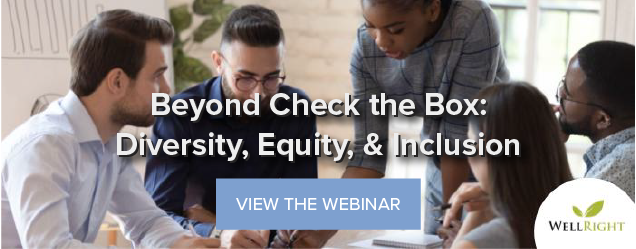Editor's Note: We recently updated this post with new insights.
Employers who seek to infuse diversity, equity, and inclusion (DEI) throughout their organizations know the value of metrics in learning about the real impact of their initiatives. Analyzing the right metrics enables leaders to measure and quantify progress and promote accountability at every level.
What most employers may not realize is that they can use another type of initiative that adds tremendous value in quantifying the success of DEI efforts.
And the best part? They may already have the data available.
Enter ESG, which stands for “environmental, social, and governance.”
ESG initiatives, by their nature, track metrics for reporting specifically to boards of directors, stakeholders, and other major regulatory bodies.
And as it turns out, the intersection between DEI and ESG can be leveraged to help organizations better measure and optimize both types of programs.
Related Content: CSR, ESG, and DEI: Your Key to the Workplace Culture Employees Want
What is ESG?
Environmental, social, and governance (ESG) initiatives are traditionally implemented to show investors how viable companies are now and in the future. These programs evaluate how socially conscious an organization is based on its commitment to and involvement in a variety of social and environmental causes.
An employer's ESG score reflects that commitment and the metrics that measure each aspect of ESG from an environmental, social, and governing perspective.
 Environmental
Environmental
The environmental aspect of ESG refers to an organization's commitment to eco-conscious efforts including climate change, greenhouse gas emissions, waste disposal, and energy usage. For example, by creating programming and initiatives to reduce its carbon footprint, an organization can improve its environmental score.
Analyzing how an employer sources materials, whether or not solar energy is being explored, or the efficacy of a universal recycling program are all concerns that must be considered as part of an ESG score.
The environmental aspect also involves taking steps to fall more in line with the priorities of stakeholders, including investors and employees. For example, 75% of millennial employees say they will pay more for sustainable products, and 77% are conscious of how the products they buy impact the environment.
 Social
Social
The social aspect of ESG varies widely, from political views and labor standards to belonging and inclusion.
In other words, the social aspect of ESG is where DEI initiatives thrive.
Knowing how this aspect impacts an organization's overall ESG score is important. If investors determine that business practices are, for example, exploiting workers and forcing labor in third-world countries, they may decide to opt out. Internally, if an organization's DEI program is more lip service than action and results, employee retention and recruitment will suffer as well.
 Governance
Governance
The last aspect of ESG is governance, which measures an employer's stewardship through its leaders, mission, vision, and action. This includes auditing business practices, organizational structure, and even shareholder compensation.
To put this in perspective, if a CEO is found guilty of fraud or spends little time actually leading or working, that organization's governance score will suffer. This will go on to impact future investments, partnerships, and client relationships.
The Ethics of ESG
All three aspects of ESG pose three ethical questions for employers to answer, especially when it comes to evaluating DEI strategies:
- What responsibilities can our organization adopt to protect the environment?
- What roles do human rights, dignity, and respect play in our organization?
- What impact should our organization have on our industry and the standards to which all other organizations are held?
That question of ethics has garnered much attention from many employers—both positively and negatively—in regard to DEI. At this point, not only is DEI a component of the social aspect of ESG, but it has also become table stakes.
Currently, the question is less about whether a company simply has a DEI program. Instead, investors, job candidates, and employees want to know how seriously employers are taking their DEI programs, how pervasive they are, what kinds of checks and balances are in place, and whether they are truly effective.
“DEI has moved from a nice-to-have to a must-have for companies that want to remain successful,” said Ty Chandler, Senior Diversity, Inclusion, & Belonging Lead at AvidXchange, an accounts payable automation software company headquartered in Charlotte, NC. "However, a DEI program should never be just about checking a box."
Chandler went on to explain how her company approaches DEI initiatives through the lens of ESG implementation.

And as it turns out, customers watch more closely than you might think. PwC reports that consumers want to know about the DEI programs in place at their favorite companies, and they want transparency around metrics, key performance indicators, and effectiveness.
That poses a challenge for some employers.
While the environmental and governance aspects are easier to track because the data points are finite and quantitative, measuring social issues is more challenging. But without those metrics, it’s even more difficult to show leadership how DEI initiatives impact day-to-day activities and the bottom line.
DEI programs rely on executive sponsorship and management participation. Executives and managers need tangible evidence that their involvement makes a difference. Without both, employers may find themselves going through the motions with little results.
So, how can you improve your organization's DEI metrics while developing your social ESG score?
Improving Social ESG Metrics
Research from Gartner confirms that DEI programs can deliver positive results in terms of employee performance. By prioritizing the right metrics, employers stand to see:
- 2% improvement in day-to-day effort
- 5% spike in retention
- 3% boost in individual employee performance
Plus, organizations infused with inclusion are 120% more likely to hit their financial target goals. Diversity initiatives have a similar impact and correlate to outperforming financial KPIs. And when it comes to innovation, more diversity equals faster innovation.
However, you still have to show how these programs make an impact in your organization. To do that, you need to set a baseline, identify priorities, link them to corporate goals, and track them with KPIs.
1 Conduct an Inclusion Audit
Without a baseline, it’s nearly impossible to measure progress. The first step in quantifying DEI program success is to conduct an inclusion audit, even if you already have DEI programs in place.
It’s essential to know where you’re starting from, especially when there may be inherent biases that could be impeding program progress. Some important questions to ask during your audit include:
- Do our forms have a section for pronouns?
- How are families defined, and what naming conventions are used to describe spouses and children?
- What magazines and signage are displayed in our offices and waiting rooms?
- Who is involved in the hiring process, and do they represent the diversity we wish to see in our organization?
- Are there clear mentorship opportunities and promotion paths for employees in underrepresented groups?
- How are the needs of those groups communicated to management?
Related Content: How to Create a Successful Employee Resource Group (ERG)
2 Establish Employee Resource Groups (ERGs)
Employee resource groups (or ERGs) serve several functions within an organization. They create safe spaces for underrepresented employees to network and brainstorm ways to make initiatives more inclusive.
Plus, ERGs can serve in an advisory role to your DEI programs by taking inclusion audit results and prioritizing the opportunities presented.
3 Set Clear Goals Tied to KPIs
With the help of your ERG, you can determine what needs to happen in the short- and long-term to create a culture of belonging and inclusion for your employees. Keep in mind that these goals should be SMART (specific, measurable, action-oriented, reasonable, and time-specific) so you can measure clear outcomes and deliver data-driven results to leadership.
Another factor that will help make your goals more achievable and impactful is to tie them to company KPIs.
For example, if your company has a hiring target for the new year, create a goal within that KPI that details the diversity target for those new hires. Within your training and development goal, clarify how many or what percentage of employees within underrepresented groups should complete leadership training.
The point is to make sure each of your DEI goals is directly linked to a corporate goal to ensure they are given equal priority.
By understanding how to measure DEI programs, your company can improve its overall ESG score and attract the stakeholders needed for internal and external success. If you would like guidance in developing your DEI program or have any questions about how to put these ideas into practice, WellRight can help.




